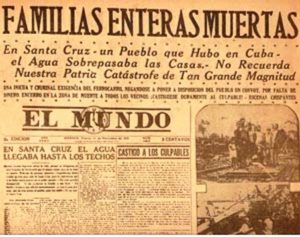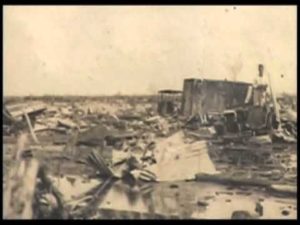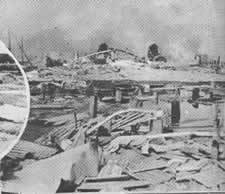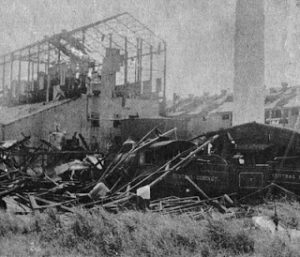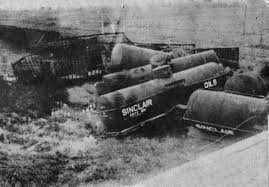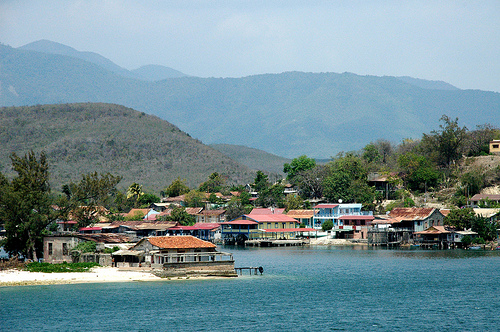At dawn on Wednesday, November 9, 1932, one of the most violent hurricanes known in the history of Cuban meteorology, it penetrated a point about 60 kilometers west of the fishing village of Santa Cruz del Sur and left the vicinity of the bay of Nuevitas, on the north coast of the province.
The entrance of the hurricane in land of the province of Camagüey takes place in the first hours of the morning of the 9 of November. The meteor penetrates the Punta de Macurije, approximately 60 km west of the town, exposing the small town to the terribly combined battle of the wind and the sea.
Winds of more than 270 kilometers per hour caused enormous loss of life and material damages in the province of Camagüey. The sea, propelled by the winds, penetrated with waves of up to three meters of height about 25 kilometers inland, causing in the first impact the death to 2 700 people in the municipality of Santa Cruz of the South.
Far away from there, trunks originated by the hurricane winds lashed the towns of Camajuaní and Caibarién, also to the north of the island, causing thirty more victims.
The hurricane of high intensity with winds that surpassed 250 km / h demolishes the strong winds of the east wing of the phenomenon, that blowing from the sea to the earth, pushed on the city, located one meter and a half above the level of the sea, waves that reached, at the climax, heights between 22 and 30 feet, which literally buried the locality.
This was not a phenomenon as traditionally asserted, but rather a gradual process that intensified as the hurricane approached. Between 4 and 5 AM on day 9, sea water began to enter the village and to raise its level as the tide rises, gradually. Around 9 am the waters reached more than 3 m in height. As early as 11 o’clock in the morning, including the waves caused by the hurricane wind, the sea level was up to 30 feet high, that is, almost 9 m high.
It is estimated that the loss of lives exceeded three thousand people between drowned, crushed by the roofs and walls of houses that came to the ground and the missing. Many people were dragged by the waters when the sea withdrew, their corpses appearing between the cays and channels of Twelve Leagues more than twenty kilometers away, or scattered in the archipelago of Guacanayabo. Others were never found. The material losses were calculated in millions of pesos, although in truth they could never be counted.
Among the cities that suffered more intensely “the 32nd cyclone”, as it has since been known in the annals of world meteorology, besides Santa Cruz del Sur, Camagüey, Ciego de Avila, Morón, Florida, Nuevitas, Júcaro, Vertientes, Jatibonico, Camajuaní and Caibarién, as well as dozens of large and small towns located on the south coast, from Cienfuegos to the east.
So far this has been the most violent huracan that has destroyed Cuba in the last 85 years.
EL HURACAN MÁS VIOLENTO EN AZOTAR A CUBA. SU HISTORIA.
En la madrugada del miércoles 9 de noviembre de 1932 uno de los huracanes más violentos conocido por la historia de la meteorología cubana, penetró por un punto situado unos 60 kilómetros al oeste de la población pesquera de Santa Cruz del Sur y salió por las inmediaciones de la bahía de Nuevitas, en la costa norte de la provincia.
La entrada del huracán en tierra de la provincia de Camagüey tiene lugar en las primeras horas de la mañana del 9 de noviembre. El meteoro penetra por la Punta de Macurije, aproximadamente a 60 Km. al oeste del pueblo, exponiendo a la pequeña ciudad al embate terriblemente combinado del viento y el mar.
Vientos de más de 270 kilómetros por hora causaron enormes pérdida de vidas y daños materiales en la provincia de Camagüey. El mar, impulsado por los vientos, penetró con olas de hasta tres metros de altura unos 25 kilómetros tierra adentro, causando en el primer impacto la muerte a 2 700 personas en el municipio de Santa Cruz del Sur.
Muy lejos de allí, trombas originadas por los vientos huracanados azotaron los pueblos de Camajuaní y Caibarién, también al norte de la isla, causando una treintena de víctimas más.
El huracán de alta intensidad con vientos que sobrepasaban los 250 Km/h hace abatir sobre la población los fuertes vientos del ala este del fenómeno, que soplando del mar a la tierra, empujaron sobre la ciudad, situada a metro y medio sobre el nivel del mar, olas que alcanzaron, en el momento clímax, alturas entre 22 y 30 pies, las cuales literalmente sepultaron la localidad.
No fue este fenómeno un ras de mar como tradicionalmente se afirmó, sino un proceso gradual que fue intensificándose a medida que el huracán se acercaba. Entre las 4 y 5 de la madrugada del día 9, el agua del mar comenzó a entrar en el pueblo y a subir su nivel como sube la marea, paulatinamente. Alrededor de la 9 de la mañana las aguas alcanzaban más de 3 m de altura. Ya a las 11 de la mañana aproximadamente, incluyendo el oleaje provocado por el viento huracanado, el nivel del mar ascendió hasta 30 pies de altura, o sea, a casi 9 m de altura.
Se calcula que la pérdida de vidas excedió las tres mil personas entre ahogados, aplastados por los techos y paredes de las viviendas que vinieron al suelo y los desaparecidos. Muchas personas fueron arrastradas por las aguas cuando el mar se retiró, apareciendo sus cadáveres entre los cayos y canalizos de Doce Leguas a más de veinte kilómetros de distancia, o dispersos en el archipiélago de Guacanayabo. Otros jamás fueron encontrados. Las pérdidas materiales se calcularon en millones de pesos, aunque en verdad nunca se pudieron contabilizar.
Entre las ciudades que sufrieron más intesamente “el ciclón del 32”, como desde entonces se le conoce en los anales de la meteorología mundial, se encuentran, aparte de Santa Cruz del Sur, Camagüey, Ciego de Ávila, Morón, Florida, Nuevitas, Júcaro, Vertientes, Jatibonico, Camajuaní y Caibarién, así como decenas de grandes y pequeñas poblaciones situadas en la costa sur, desde Cienfuegos al este.
Hasta hoy, este ha sido el Huracan más destructivo en Cuba en sus últimos 85 years
Agencies/Wiki/Various/Adelante/Internet Photos/YouTube/ Arnoldo Varona/ TheCubanHistory.como
THE CUBAN HISTORY, HOLLYWOOD.



